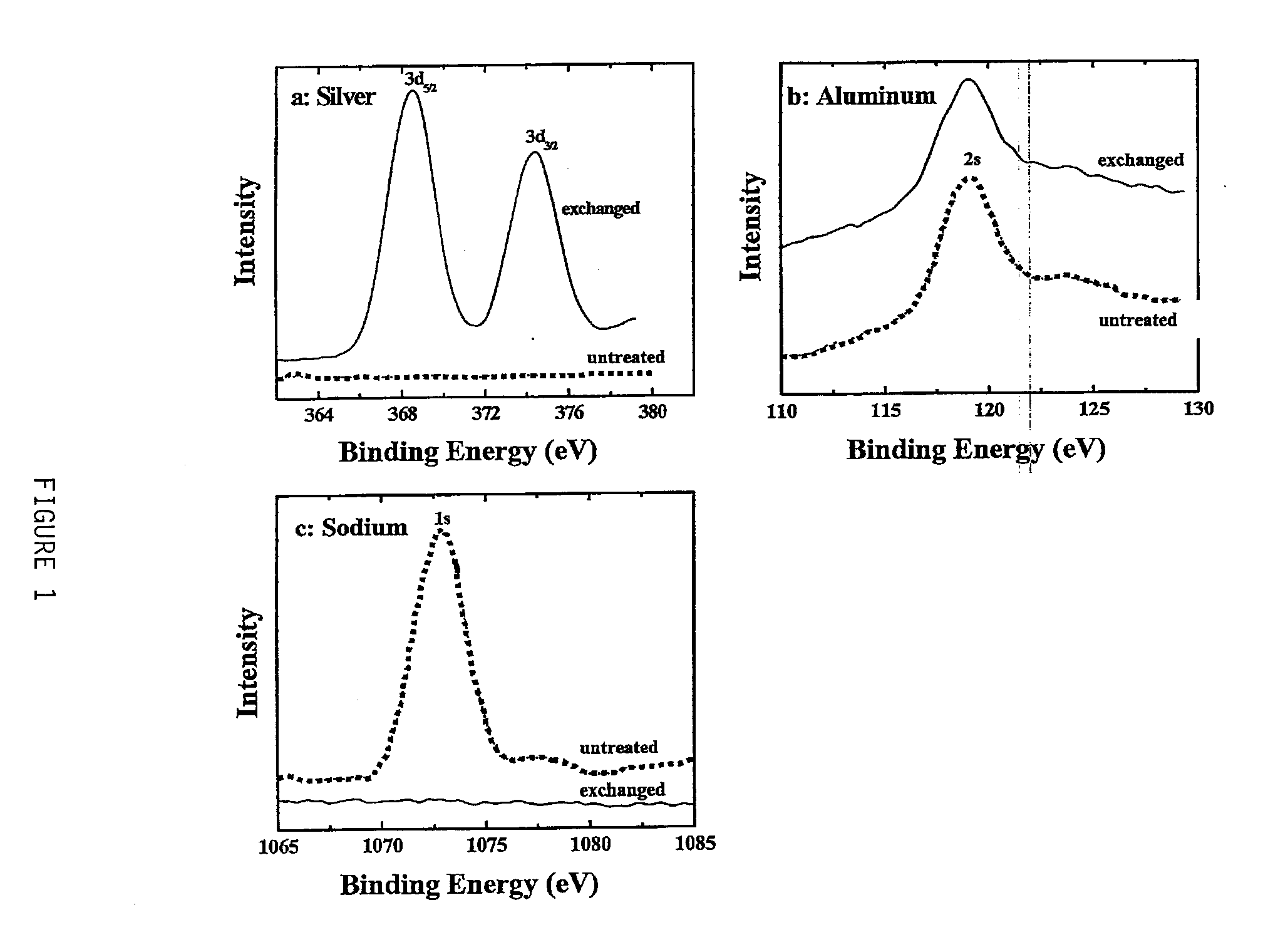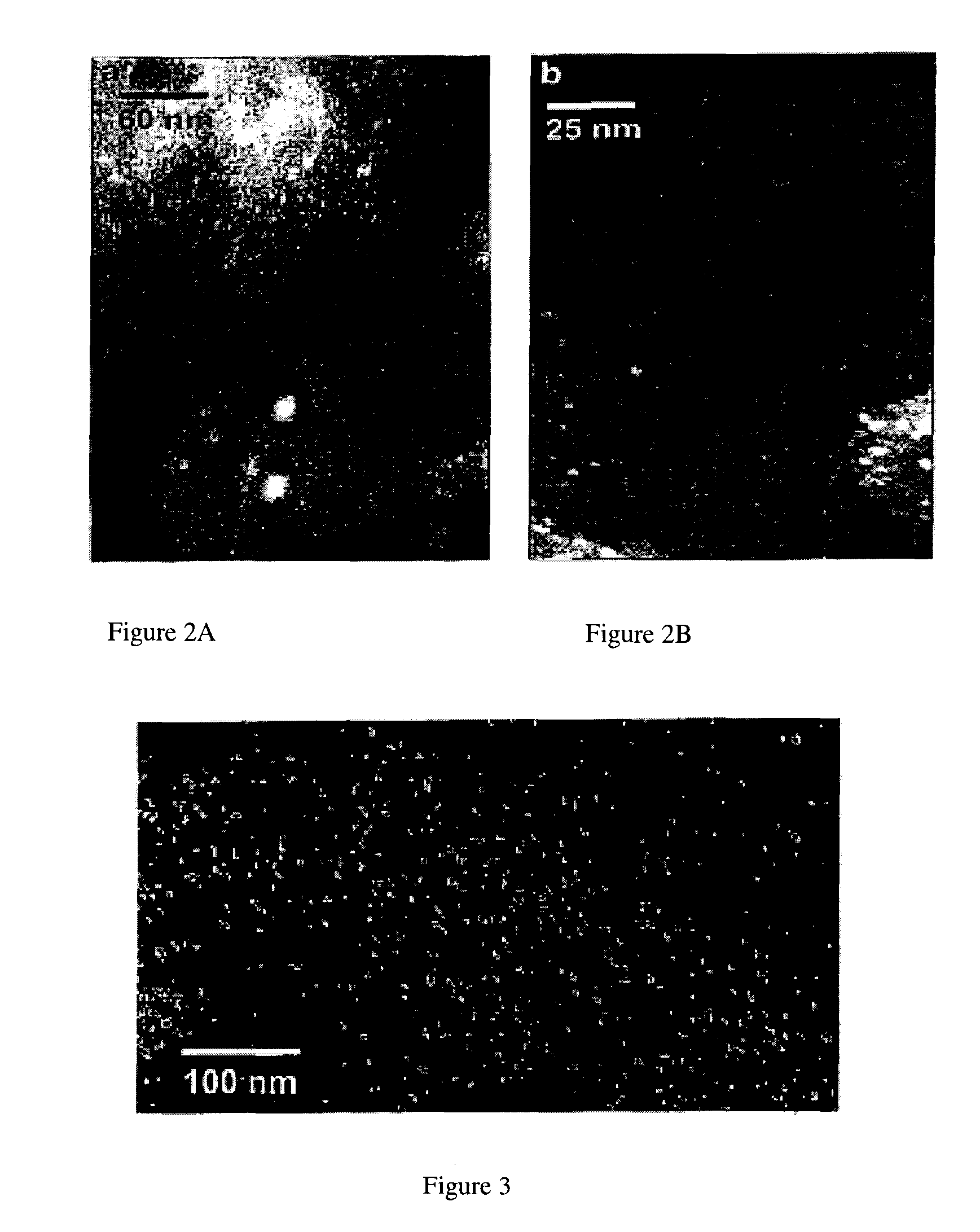Mercury absorption using chabazite supported metallic nanodots
a technology of metallic nanodots and chabazite, which is applied in the field of silver nanodots, can solve the problems of not being able to capture elemental mercury from the flue gas of coal-fired power plants, unable to meet the mechanistic requirements of carbon-based sorbents for elemental capture, and undesirable mercury emissions from industrial processes such as coal-fired power plants
- Summary
- Abstract
- Description
- Claims
- Application Information
AI Technical Summary
Benefits of technology
Problems solved by technology
Method used
Image
Examples
example 1
[0043]Sedimentary chabazite from the well-known deposit at Bowie, Ariz. was utilized as the zeolite support, obtained from GSA Resources of Tucson, Ariz. (http: / / gsaresources.com). Aluminum enriched chabazites were prepared by prolonged digestion of the raw ore in alkaline silicate mixtures for 1-3 days at 80° C. The degree of aluminum enrichment was governed by the amount of excess alkalinity available during the digestion and recrystallization process.
[0044]Phase identification of chabazite and aluminum enriched analogs was conducted by X-ray diffraction analysis using a Rigaku Geigerflex Model 2173 diffractometer unit. As is typical of samples from the Bowie deposit, XRD analysis indicated that the material was highly zeolitized with chabazite being the dominant phase. The material also contained significant clinoptilolite and erionite as contaminants as seen in FIG. 6A. Caustic digested enhanced or aluminum enriched materials were found to gain intensity for the chabazi...
example 2
Formation of Silver Nanodots
[0045]Silver ion-exchange was accomplished by exposure of the chabazite as 200 mesh powders to an excess of aqueous silver nitrate at room temperature with stirring for 1 hour. The exchanged materials were thoroughly washed with deionized water, and dried at 100° C. To convert the silver ions in the zeolite to supported metallic silver nanoparticles, the ion-exchanged chabazite was activated at temperatures ranging from 150° C. to 450° C., for periods of 1-4 h in air.
[0046]Successful ion exchange was confirmed by x-ray photoelectron spectroscopy (XPS). FIGS. 1A-1C show the intensity (given in arbitrary units) versus binding energy XPS spectra for the untreated (dotted line) and the ion-exchanged (solid-line) chabazite. An intensity shift between the two spectra was added to separate the peaks which would otherwise overlap. As shown by the spectra in FIG. 1A, silver is present on the surface of the silver-exchanged chabazite but is absent on the surface of...
example 3
[0053]Auger microscopy was performed by a JEOL JAMP-9500F Field Emission Scanning Auger Microprobe. The instrument was equipped with a field-emission electron gun and hemispherical energy analyzer. Identically prepared powders were used for the microprobe analysis as for the TEM.
[0054]FIG. 3 shows a scanning Auger microprobe image of the Ag distribution on the chabazite surface. The silver particles appear slightly larger in the microprobe images relative to the TEM-obtained results. Their distribution also appears less dense. The number density difference may be attributed to the fact that a TEM image shows a minimum of two surfaces (chabazite is a finely layered structure where there are likely more than two surfaces present in each electron transparent sample), while an Auger image simply shows the top surface. The larger apparent particle size may be partly due to the inferior spatial and analytical resolution of the microprobe relative to the TEM, since out-of-f...
PUM
| Property | Measurement | Unit |
|---|---|---|
| Particle size | aaaaa | aaaaa |
| Particle size | aaaaa | aaaaa |
| Particle size | aaaaa | aaaaa |
Abstract
Description
Claims
Application Information
 Login to View More
Login to View More - R&D
- Intellectual Property
- Life Sciences
- Materials
- Tech Scout
- Unparalleled Data Quality
- Higher Quality Content
- 60% Fewer Hallucinations
Browse by: Latest US Patents, China's latest patents, Technical Efficacy Thesaurus, Application Domain, Technology Topic, Popular Technical Reports.
© 2025 PatSnap. All rights reserved.Legal|Privacy policy|Modern Slavery Act Transparency Statement|Sitemap|About US| Contact US: help@patsnap.com



